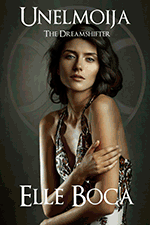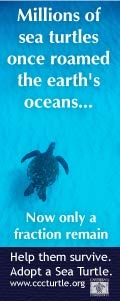Luxury Travel Review

Princess won us over for cruise experience
Article by Andrea de Gosztonyi and Douglas McRae and photos by Andrea de Gosztonyi
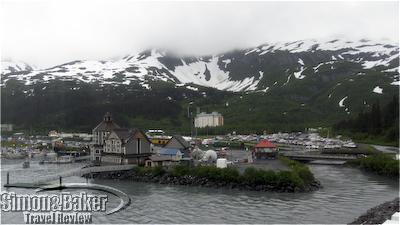
A stop during our Alaska cruise
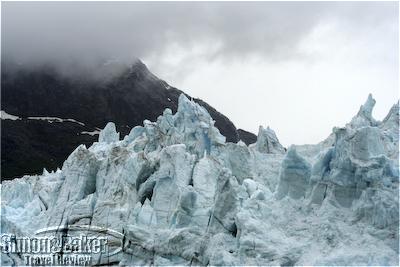
Ice in Alaska
Summer is the best time for an Alaska Cruise. My husband needed to be in Anchorage Alaska for the middle of July and so we chose to travel on the Island Princess, which is part of the fleet of Princess Cruise Lines. We chose an eight day, seven-night north bound cruise to Whittier Alaska, United States. We sailed the inside passage, viewed massive glaciers and stopped at several ports on the way. We embarked in Vancouver British Columbia Canada and sailed past Stanley Park, the Lions Gate Bridge and through the offshore islands. From the deck, we saw the majestic snow capped Rocky Mountains.

Alaska during our cruise
We also were on the lookout for dolphins, whales, porpoises and sea otters. We enjoyed our first port call in Ketchikan, the ancestral home of the Haida, Tlingit and Timshian Native Tribes. We docked in Juneau, the capital of the State of Alaska and spent the day exploring its many sights. Skagway, gateway of the Klondike Gold Rush was our next stop. We also saw calving glaciers in Glacier Bay and College Fjord and we cruised the Prince William Sound which is at the top of the Gulf of Alaska. We disembarked in the town of Whittier, located 60 miles south of Anchorage.
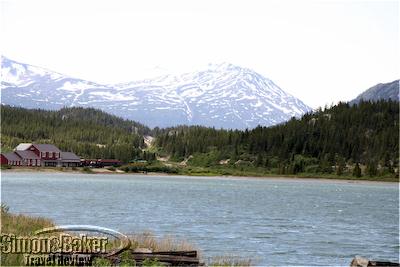
A view during our Alaska cruise
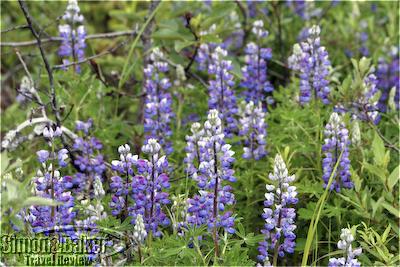
Alaska flowers
It was our first time on a cruise and we were not sure that we would enjoy travelling in such a confined space. We were wrong! The Island Princess was spacious and luxurious, the rooms were cozy and comfortable, the attention we received from the staff was exceptional and attentive and the food was fabulous!. Cruising at night and visiting interesting ports of call is a winning formula and we were completely won over. Click here for details about our Island Princess Vancouver to Whittier cruise.
Verizon Blackberry Storm Excellent on the Road
In today’s rapidly evolving marketplace of smart phones, the Blackberry Storm from Verizon raises the bar with several unique features. Its compact form fits comfortably in the hand or pocket with minimal external controls to mar its sleek solid feel and sleek design. With the screen lock enabled, the phone fit comfortably into a pocket with the need for a protective case.
The unit we tried had an 8GB mini-SD installed and came with an international plug package that was useful in Europe; no additional adapter was required to charge the phone in Germany. We tested the phone for several weeks in Colombia, South Africa, Botswana, the U.S. and in Europe (Germany and France). It worked perfectly as a cell phone and Internet access functioned everywhere we tried it. It seemed that the high speed 3G network was available most of the time.
From the first touch, it is clear that this is not an ordinary phone. The bright screen is eye catching with a solid glass surface that actually clicks when pressed. Combined with onscreen displays it creates a totally unique feedback system for the user. The tactile response allows much faster use of the touch screen because the fingers know how many times a particular item was pressed. With many other touch screens, the visual queues take a second to be processed.
Another great feature is the rotation of the display as the phone turns, which is enabled in every application. Some competing systems provide a similar response when the phone is turned, but most do not have it as deeply ingrained into every application as the Storm. For those users with large fingers, the sideways full screen keyboard was a real blessing.
Web access was smooth and natural with excellent reproduction of most web pages on the tiny screen. A few quick finger motions allow for rapid navigation and scaling in an intuitive manner, and made browsing practical in spite of the lack of a keyboard. It was great having a fully functional browser always along to quickly look up an address or phone number.
Email setup was made easier by predefined wizards for common mail services, but even regular POP configuration was quickly accomplished. The built-in camera allowed us to send instant postcards to friends and family using email attachments. With a 3.2 Megapixel photo size, a built in image stabilizer and video capability, the Storm offers multiple options to capture the moment.
The application suite that came with the phone allowed download of movies and audio files for playback on the Storm. The video format produced a nice picture quality with practical volume on the speakers, although the application took quite a bit of time to convert to the format used on the phone. The software was Windows based and the install was straightforward.
Once installed and connected to the phone, audio, video and images could be loaded into the chip memory installed in the phone or extracted to backup the smartphone to the computer. We like the idea that the micro-SD memory capacity can grow with technology, a serious advantage over competitors with hard wired RAM for storage.
A favorite feature was the data modem which allowed the laptop to access the Internet through the smartphone high speed network access. Fair use rules apply and allow a liberal amount of network access when traveling. We had less success in Europe, it was trying to connect to the German parent company for Verizon, but just never quite got it working.
In summary, the Verizon Storm has a number of features that make it a serious contender for the Apple iPhone. With swappable memory cards and batteries, smaller size, improved photo and video capability, tactile feedback and fully integrated display rotation, the Blackberry Storm sets the bar higher and will attract business users interested in a highly functional international phone.
La dolce vita, Tuscany style
Article and photos by Josette King
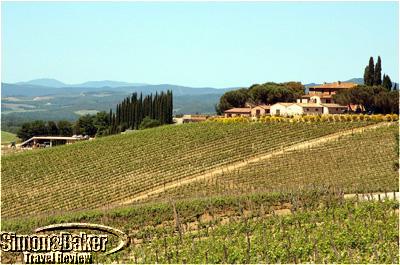
Altesino Estate in Tuscany
This was la dolce vita at its best. Not the Fellini kind with dark-of-night Vespa races through the streets of Rome and impromptu dips in Bernini fountains but a leisurely discovery of the famed cultural and natural wonders of Tuscany. Our recent journey into the sweet life began in Florence where we lingered for a week, taking in the flavor of the city and its lesser frequented artistic gems as well as the world-renowned guidebook “must” sites.
We then headed south to the province of Siena and our base for the second week of our Tuscan holiday at Le Capanne, a luxury villa near the ancient hamlet of Camporsevoli on the border with Umbria, the neighboring state. From there we motored along back roads of the Chianti and Val d’Orcia, our daily explorations taking us to famed medieval cities such as Siena, Montepulciano and Bagno Vignoni, feasting our eyes along the way on rolling hills covered with quilts of vineyards, meadows and olive groves.
While we could have planned a satisfying trip using the extensive material available to potential tourists, a truly memorable escapade required the assistance of a local whose help and suggestions ensured that we experienced not only the sites but the very essence of Tuscany. Valentina Grossi, founder and manager of One Step Closer, a customized luxury tour company in Florence, was our local contact. She focused on our special areas of interests to create memorable adventures.
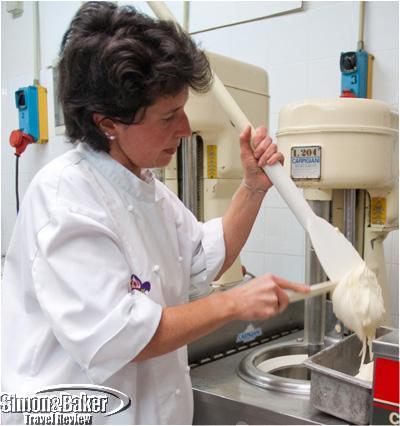
Silvana Vivoli, scoops out a batch of Crema, the shop's most popular gelato
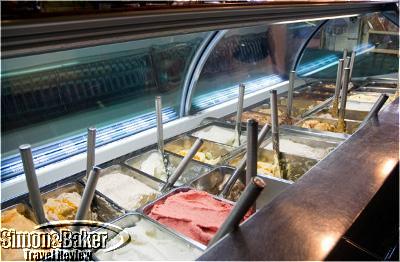
Vivoli gelati have delighted customers for 80 years
When I confessed my addiction to gelato, the decadently rich semi-soft Italian ice cream, Valentina was not content to recommend a visit to Vivoli (considered for several decades one the best gelaterias in Florence). Rather she arranged a visit with Silvana Vivoli, the grand-daughter of founder Raffaello Vivoli and current owner. We met in her laboratory where I spent a blissful hour discussing with her the finer points of gelato-making and sampling the elegant flavors that emerged from her slow-churning stainless steel centrifuges.
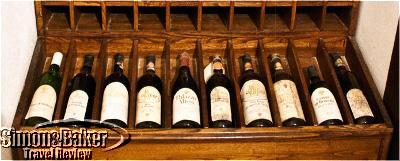
The Altesino Estate produces the famed Brunello di Montalcino
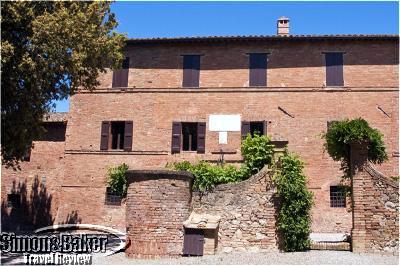
A record of the best vintages is kept in the Altesino library
Personal friendships dating back several generations between Valentina’s family and the owners of private art collections, landmark palazzi and exclusive wineries opened doors to experiences usually unknown to tourists. In Valentina’s company, we were welcomed by Maria Vittoria Corti Grazzi, current owner of Palazzo Peruzzi. The palace, located a few steps away from the Piazza Santa Croce, is the last privately owned palace of the Peruzzi family, a Florentine dynasty reaching back to the 14th century. In addition to a private viewing of her eclectic art collection ranging from Roman sarcophagi and Byzantine icons to a number of Florentine 17th century paintings, Maria Vittoria graciously led us on a tour of the beautifully decorated reception rooms of her palazzo.
The following week, aware of my keen interest in enology, Valentina arranged a private visit of Altesino, an esteemed boutique winery in Montalcino, where Managing Director Guido Orzalesi guided us through the entire production cycle of their superb Brunello and Rosso di Montalcino wines before treating us to a sumptuous luncheon and tasting of Altesino’s prized vintages. Even in Italy, life doesn’t get any sweeter! Click here for more about my visit to Tuscany and stay at Le Capanne at Camporsevoli.
The City of Sails: a welcome antidote for jetlag
Article and photos by Josette King
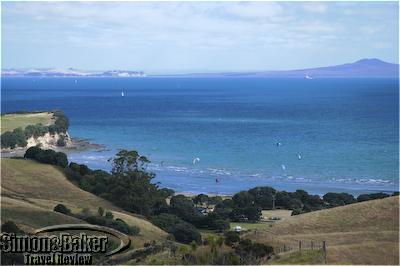
A sea view in Auckland
After the seemingly endless night flight from the United States, watching Auckland, New Zealand, sparkle beneath the plane in the early morning sunshine felt like an especially crisp breath of fresh air. The City of Sails, as Auckland is called, immediately delivered on its nickname. Built on a narrow stretch of verdant hills between the South Pacific Ocean and the Tasman Sea, the city welcomed me with a gentle sea breeze and a translucent morning sky that was an invitation to a walk.
Although its 1.3 million residents (roughly one-third of the country’s population) make Auckland the largest and most densely populated urban center in New Zealand, the city center was remarkably uncrowded. Its lush parks and laid-back atmosphere evoked a college town, rather than the main commercial and industrial hub of New Zealand.
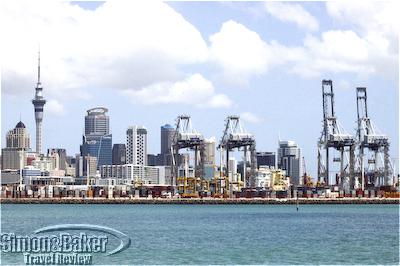
Auckland, a city skyline
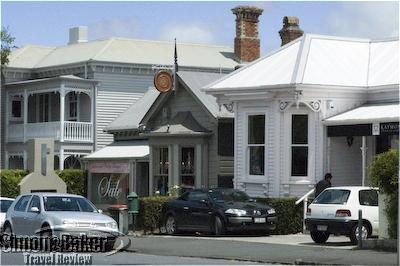
A street in Auckland
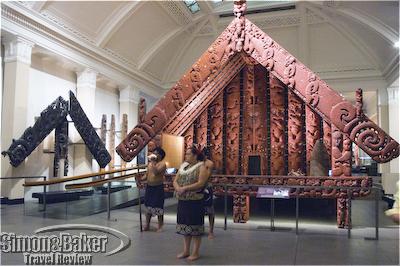
Inside the Auckland Museum
In Auckland, all roads slope toward the sea. I soon found myself boarding one of the many tour boats for an exhilarating cruise of the harbor and the stunning seascapes beyond. The pristine, shimmering sea was filled with sailboats of all sizes, its coastline festooned with coves bristling with marinas. The horizon was dotted with the soft outline of ancient volcanoes.
In the bracing sea air, I could feel the woolly feeling of jetlag literally wash away from me. After resetting my internal clock with a satisfying night’s sleep, I spent the next day enjoying the historic Parnell neighborhood and the Auckland Museum, which houses one of the most extensive and significant collections of Maori and Pacific Islands artifacts in the world.
One last day to explore the spectacular black sand beaches of the Tasman Sea just north of Auckland and I felt fully adjusted to South Pacific time and atmosphere. I was ready for the four-hour flight to Sydney, my final destination, and my full schedule ahead. Click here for more on my extended stop-over visit to Auckland, New Zealand
Delighted with Black Forest, southwest Germany
By Elena del Valle, photos by Gary Cox
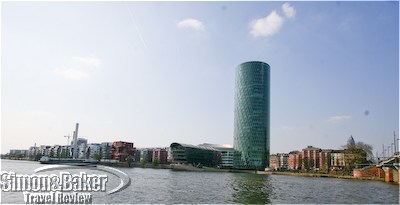
Frankfurt was our gateway to Germany's Black Forest
Earlier this year, my husband and I had an opportunity to visit the famed Black Forest and nearby areas of southwestern Germany. We were pleased to discover several small family owned and managed hotels, part of the Romantik chain of 200 independently owned and managed hotels and restaurants in 11 European countries, offering comfortable and modern accommodations including some with spa facilities. We were especially delighted with the friendly and welcoming hosts and their staff, striking scenery and outstanding foodie havens we visited during our two-week drive through the countryside.
Although neither of us speaks German we had visited that European country in the past and were confident we would have a pleasant trip. In past trips to Germany most of the business people we encountered spoke some English so we were surprised to discover that once we veered off the urban core of Frankfurt, English was scarce. So we made do with our few phrases of German and many smiles. Almost without exception locals made us feel welcome with their warm and friendly attitude. Whether it was fellow guests, staff or strangers in public areas someone was always willing to listen to our broken German and communicate with us.
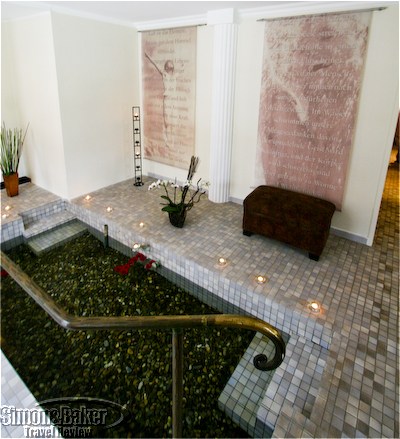
A quiet area at Bollant's Spa
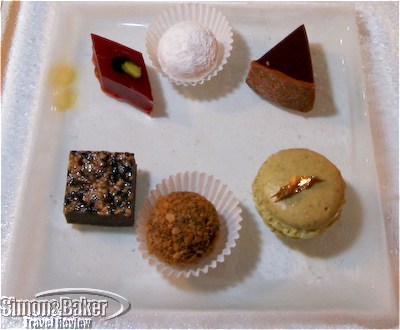
Petit fours at Passione Rossa
After landing in Frankfurt and picking up our spiffy German rental car with heated seats (it was late winter/early spring and definitely cold) and global positioning system (GPS), we headed to the village of Bad Sobernheim where we spent two nights recovering from the jet lag and being pampered with good food and spa time at the Romantik Hotel BollAnt’s im Park, Bollant’s Spa at at BollAnt’s im Park Romantik Hotel and Vital Spa and Passione Rossa restaurant.
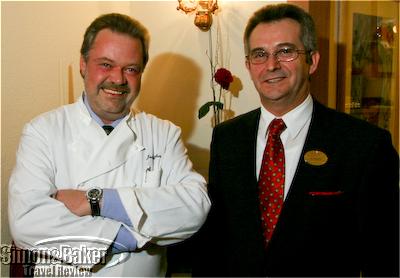
Jörg Glauben and Birgit Neumueller at Tschifflik restaurant
We also visited the Romantik Hotel Landschloss Fasanerie on the outskirts of the town of Zweibrucken near France. Once again we took advantage of the property’s spa services and sampled its outstanding local and continental cuisine. Before leaving we had a gourmet dinner at the well known Tschifflick.
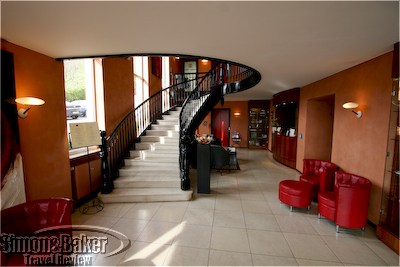
The lobby at Residenz am See in Meersburg

A delicate fish course at Casala
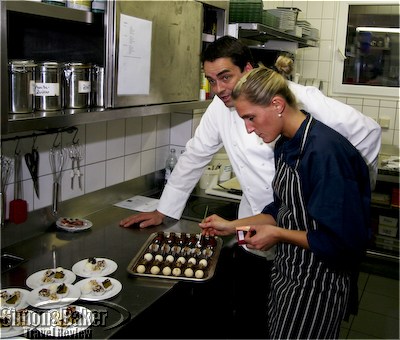
Behind the scenes at Residenz am See
From there we headed south through snow covered mountains to Meersburg, a small and picturesque village with cobblestone streets on the shores of Lake Constance. We thoroughly enjoyed our brief stay in a penthouse suite at the Romantik Hotel Residenz am See, one of our favorite properties during the trip for sheer friendliness, a well appointed suite and delicious food. While we were there we attended a German pastry baking class in German. With the help of our small group of fellow students and the pastry chef’s interjections we learned a little and had a fun morning baking delicious regional and German treats. Meals at the hotel restaurants including dinner at Casala Restaurant, were outstanding!
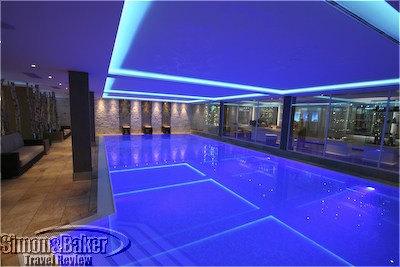
The Romantik Hotel Sackmann Spa pool
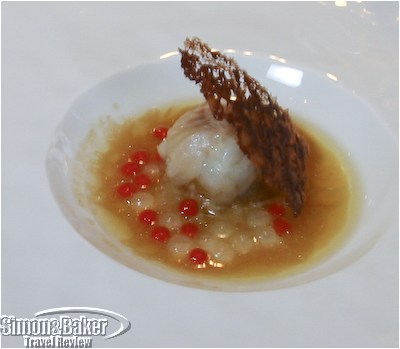
One of the delicious dishes we tried at the Restaurant Schlossberg
From there we returned to the Black Forest to the Romantik Hotel Sackmann in the municipality of Baiersbronn. We especially liked the hotel’s riverside location, gourmet restaurant and fabulous spa facilities.
We would recommend the region to scenery, spa and gourmet food oriented friends and acquaintances willing to venture to areas where English is not commonly spoken. As an added bonus this part of Germany offered great value for money compared to urban areas in Europe.
Coba and Ek Balam, Riviera Maya newest sites
By Andrea de Gosztonyi-McRae and Doug McRae and photos by Andrea de Gosztonyi-McRae
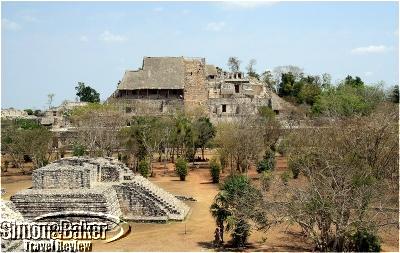
Ek Balam pyramid
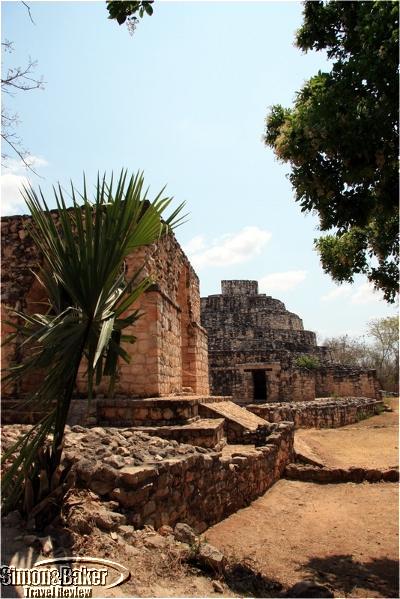
Ek Balam
Tucked away in the jungles of the Mayan Riviera in Mexico, Coba and Ek Balam are ancient Mayan ruins that are only just being discovered. As majestic as Chichen Itza, these two archaeological sites are only just coming into their own.
Ek Balam is Mayan for black jaguar and was built between 600 and 900 A.D. Excavation of this site was started only eight years ago and it is very much a work in progress. At 480 feet long, 180 feet wide and 96 feet tall, the pyramid is the grandest of the restored buildings. It is believed to have once served as a palace for court officials, on their long trek from Tulum to Chichen Itza. We found the strenuous climb to the top, over uneven steps and in the hot sun, was well worth the effort. A stunning view of the region lay at our feet.
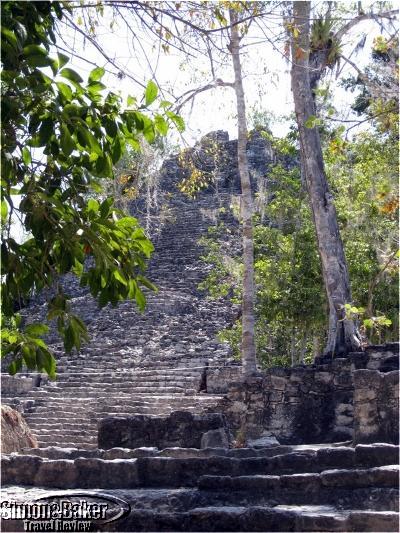
Coba pyramid
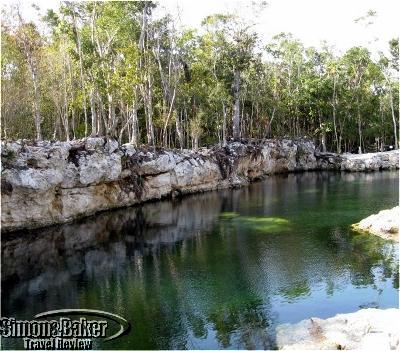
A cenote
Coba is Mayan for ruffled waters and lies deep in the jungle. A mile long walk through a luxurious shaded path took us to a clearing where the largest pyramid in the Yucatan Peninsula is located. Bicycles or rickshaws were also available at the entrance. At 136 feet high, Nohoch Mul, big hill’in Mayan, is spectacular. We found the strenuous climb up to the top amazing but the climb down was more difficult as we had to step sideways over the uneven rocks. One of the most interesting aspects of Coba is the fragments of colourfully painted murals that can still be seen there. Click here for more about our visit to Coba and Ek Balam.




